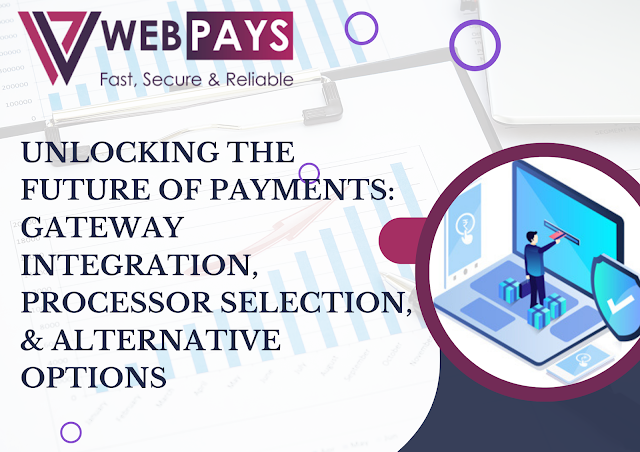Unlocking the Future of Payments: Gateway Integration, Processor Selection, & Alternative Options


In
today's digital economy, credit card processing has become essential to running
a successful business. Whether you operate in regulated businesses or
unregulated (high-risk) businesses, accepting credit card payments is crucial
for attracting customers and boosting sales. However, diving into the world of
credit card processing can be daunting, with numerous providers, fees, and
technologies to consider. In this guide, we'll walk you through the key aspects
of credit card
processing, helping you make informed decisions that benefit your
business.
Credit
card processing is the financial backbone of modern commerce. It involves a
series of steps that allow businesses to accept and process credit card
payments from their customers. Here's how it works:
1.
Payment Authorization: When a customer swipes, inserts, or enters their credit
card details, the transaction data is sent to the merchant's payment processor.
2.
Authorization Request: The processor forwards the transaction details to the
customer's issuing bank (the bank that issued the credit card).
3.
Authorization Approval or Decline: The issuing bank evaluates the transaction for
available credit and potential fraud. If approved, the bank sends an
authorization code to the processor. If declined, the transaction is denied.
4.
Payment Capture:
If authorized, the processor captures the funds from the customer's account and
settles the transaction.
5.
Funding: The
processed funds are then deposited into the merchant's bank account, usually
within a few business days.
We
learned how credit card processing works. In the next para, let’s see how to
choose an ideal credit card processing provider in Europe.
Selecting
the right payment processor is a critical decision for any merchant. There are
various factors to consider when making your choice:
1.
Fees: Different
processors charge various fees, including transaction fees, monthly fees, and
chargeback fees. Compare these costs to find a solution that provides a
transparent fee structure and aligns with your budget.
2.
Security:
Ensure the processor complies with Payment Card Industry Data Security Standard
(PCI DSS) requirements to protect your customers' sensitive data. Confirm that
it can offer high-risk credit card merchant accounts for your unique business
model.
3.
Payment Methods:
Consider the other types of payment methods you want to accept, such as mobile
wallets (e.g., Apple Pay, Google Wallet), ACH, bank transfers, wire transfers,
and cryptocurrency.
4.
Global Reach: A
credit card processor should accept all international credit cards and help
merchants find new markets.
5.
Integration:
Check if the processor can seamlessly integrate with your existing payment
system or e-commerce platform.
6.
Customer Support:
Reliable customer support is crucial, especially when technical issues arise.
7.
Contract Terms:
Review the contract terms carefully, paying attention to cancellation fees and
contract length.
The
technology landscape for credit card processing is constantly evolving.
Merchants can choose from various solutions, including:
1.
Point-of-Sale (POS) Systems: These are used in physical stores and include hardware
like card readers and software for processing payments.
2.
Mobile Payment Solutions: Mobile devices equipped with card readers and apps
allow merchants to accept payments anywhere, making them ideal for small
businesses and events.
3.
E-commerce Payment Gateways: Online businesses rely on payment gateways to securely
process payments over the internet. Popular options include WebPays, Square,
and PayPal.
4.
NFC and Contactless Payments: Near Field Communication (NFC) technology enables
contactless payments, where customers can simply tap their cards or mobile
devices on a reader to complete transactions swiftly.
Today,
almost every business has started its online venture, increasing the importance
of card-not-present payments. These payments are made via an e-commerce payment
gateway system, where customers fill in their card details online and
complete the payment.
Credit
card processing fees can eat into your profits, so it's essential to manage
them effectively. Here are some strategies to consider:
1.
Interchange Fees:
These are fees charged by credit card networks like Visa and Mastercard. While
you can't negotiate them directly, understanding how they work can help you
optimize your payment processing.
2.
Tiered vs. Interchange-Plus Pricing: Consider using an interchange-plus pricing model that
offers more transparency and can be cost-effective for many businesses.
3.
Chargeback Prevention: Implement robust fraud prevention measures to reduce
the number of chargebacks, which can result in additional fees.
4.
Monthly Statements:
Regularly review your processing statements to identify any unexpected charges
or discrepancies.
5.
Negotiate:
Don't hesitate to negotiate fees with your payment processor, especially if
you're a high-volume merchant.
Ensuring
the security and compliance of your credit card processing system is not only
essential for protecting your customers' data but also for maintaining trust.
Here are key compliance standards and security measures:
1.
PCI DSS Compliance:
High risk
merchant account providers must comply with the Payment Card Industry
Data Security Standard (PCI DSS) to protect cardholder data. This involves
regular security assessments and audits.
2.
Tokenization:
Implement tokenization to replace sensitive card data with unique tokens,
reducing the risk of data breaches.
3.
EMV Technology:
Upgrade to EMV-compliant terminals and card readers to enhance security. EMV
chips make it more difficult for fraudsters to clone cards.
4.
Data Encryption:
Use encryption protocols to safeguard data in transit and at rest.
Navigating
the world of credit card processing may seem overwhelming, but with
careful consideration of your business's unique needs and the right partner, it
becomes manageable and profitable. We recommend WebPays as a reliable
payment processing solution. With competitive fees, robust security measures,
and excellent customer support, WebPays can help your business thrive in the
digital age. Don't let credit card processing be a hurdle; make it a seamless
part of your operations and watch your business grow. Apply Now.
Comments
Post a Comment